The Leona Divide 100K Getaway
Working on my mindset on a beautiful, tucked-away stretch of Southern California
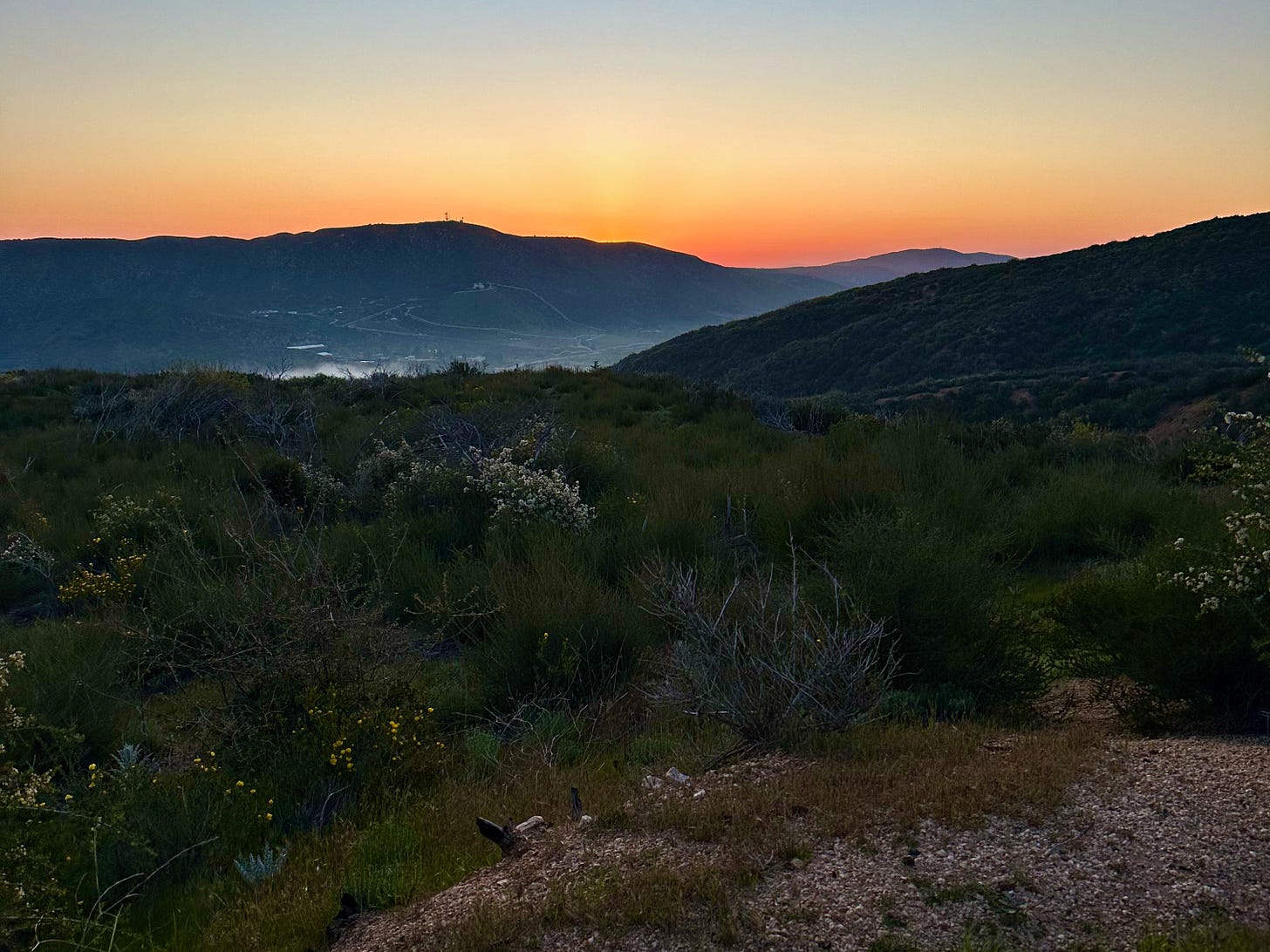
Living in a no-stoplight town, it feels jarring to return to urban centers and drive clogged freeways, as I did Friday. I flew to LAX, rented a car, and then for 1.5 hours fought traffic on the 405 to 5 to 14 to get to the very northern part of Los Angeles County.
Suburbia sprawled toward exurbia, to a region known as Antelope Valley, famous for orange blooming poppy fields. Until the 19th century, it also was famous for tens of thousands of antelope that roamed the valley, but hunters decimated the herds until they ceased exist—a reminder to me never to take the elk herds that wander past our house for granted.
Finally, near the western edge of Palmdale and Lancaster, I got on a winding two-lane road that led past ranch homes that still have cows and horses in their pastures. In the small Leona Valley (“leona” is Spanish for lioness), two lakes spread out and reflect the blue sky. I arrived at the tiny community of Lake Hughes and found the check-in for Saturday’s Leona Divide 100K.
I traveled here not only to run an ultra, but to explore these less developed, less crowded outskirts of Los Angeles and to experience a stretch of the Pacific Crest Trail. I’ve read Cheryl Strayed’s memoir Wild, about hiking the PCT, twice, and predictably, I started daydreaming about through-hiking the trail from this point in SoCal up to at least Mammoth Lakes.
I used to travel a lot—one year, all the way around the world—and these getaways to ultras feed a part of me that yearns to go to new places, see sites, meet people, and challenge myself to find my way.
I also wanted to experience a classic ultra. The Leona Divide started as a 50-miler back in 1992. It’s now managed by race director Keira Henninger, and the 100K was added in 2019. The event also has a 55K and, this year, featured an inaugural 100-miler, which 31 brave souls attempted and 21 finished. My 100K division had 100 starters, so it was nice and small, and the 50M had similar numbers. The 55K is the largest division, with around 160 starters, but they started an hour after us, so the trail did not feel too crowded.
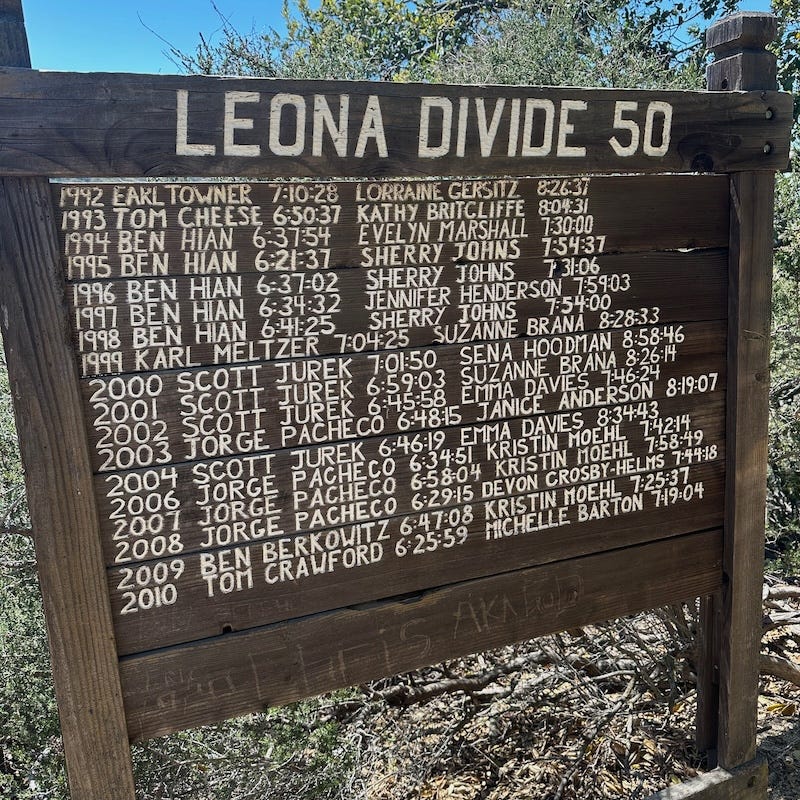
This is third year in a row I’ve been fortunate enough to travel to California in the spring—the prettiest time there and arguably the least appealing time at my place in the otherwise beautiful high-altitude San Juan Mountains. In California, all the grassy hillsides are green and flecked with wildflowers. In the Colorado mountains, the earth is still brown from mud while the grass and leaves wait another month to pop.
This is supposed to be a race report, but you can see my head was more focused on the landscape and less concerned with performance. That’s a good thing, I think, because it made me approach the start line relaxed. In fact, I felt relaxed most of the day Saturday—even as the full sun and high temps began to cook my body—with little concern for my performance other than finishing under 16 hours to gain a qualifier to enter the Western States lottery.
I thought that finishing under 16 hours would be quite manageable; I should be able to finish around 14.5 hours, based on my recent 100K times on comparable routes. (My 100K PR is 11:57 from the 2015 Tarawera in New Zealand. Sub-12 hours for a 100K seems superhuman now!)
Coming out of winter, spring ultras typically are an ass-kicker and reality check for me. They force me to get in better shape for summer races that I care more about. I entered this 100K somewhat undertrained, more in 50K shape, and used it as a season-opening daylong training run.
Mostly, I wanted to work on my mental skills: stay positive, cultivate patience, be mindful of the surroundings. Don’t get down on myself and compare myself with others on the out-and-back sections when I see all the faster competitors running back toward me; try to feel inspired by them instead. Don’t space out and trip and fall or go off course; do take care of nutrition/hydration/thermoregulation along the way. Believe in my ability to knock off a 62ish-mile ultra without too much pain or problems. Sounds simple, right?
The day started cool and easy, with smooth, runnable trail. I felt great! “This is so good,” I told myself. I reveled in being on this stretch of trail tucked out of sight from Southern California’s development. Vivid green new grass lined parts of the trail, and I loved seeing folliage, such as maroon manzanita and purple ceanothus, that don’t grow in Colorado. I shot this video clip to show how buttery-smooth the trail is in most parts:
The day didn’t turn interesting until the mile 20 turnaround point. We had bombed down a descent and had to hike back up it, ascending a little over 1000 feet in a couple of miles, which normally is not a big deal in terms of vert for my mountain legs and lungs. But the sun shone in full force while the temperature climbed to about 80, and it felt hotter on the shadeless trail with the sun reflecting off the light-colored ground. Even though I had applied sunscreen, my forearms turned reddish-brown like the manzanita while my hands puffed up as my skin tried to sweat and cool.
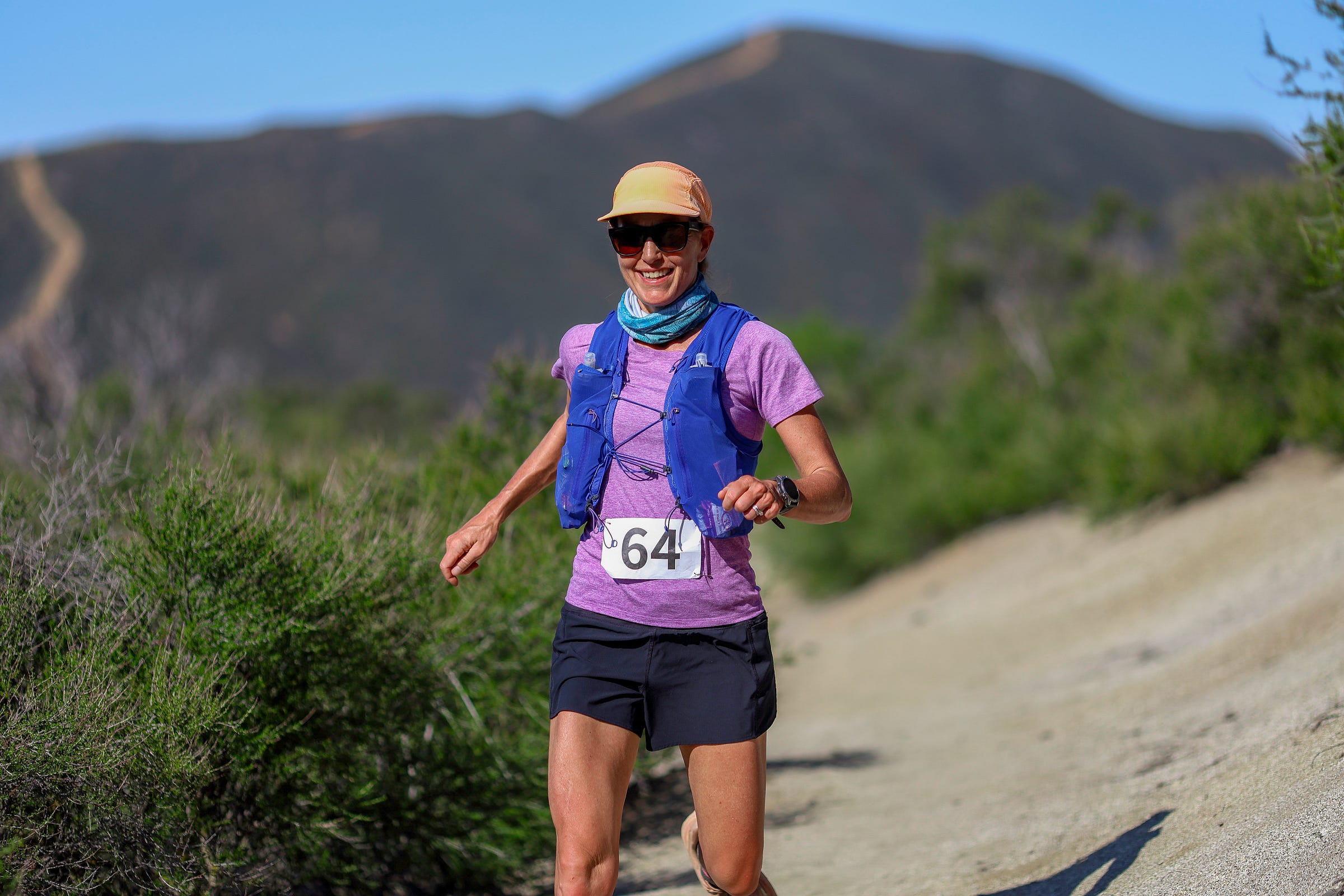
From mile 20 to 31ish, exacerbated by the heat, I started to stress out for two reasons. One, my watch’s GPS showed different mileage than the course guide indicated—my watch recorded more than a mile longer—which meant the course was measuring long and my time estimates to aid stations were off. This should not be cause for concern, but I worried I would be late to the aid station where I planned to meet my daughter, because she was going to pace me for eight miles. This triggered my other stress—my maternal angst about her and her whereabouts. I felt guilty that I had suggested she drive all this way to meet me so we could share some trail time, and guilty for making her wait. What if she can’t find the aid station? What if she wilts in this heat?
I realized I needed to chill out—to practice my favorite parenting/ultrarunning advice, “calm the fuck down”—and thankfully, water along the trail provided the opportunity to do just that. Natural springs in springtime are perhaps the most glorious aspect of this trail. Little creeks flow across the trail and in some cases run vertically like a shower. Around mile 31, I paused to stand in the flow and get wet all over. “This is so good,” I thought to myself again. And then a mantra for the day came to me: “It’s all good.” Even the hot, stressful, annoying parts. They’re part of the process and make these refreshing moments feel even better. “It’s all good,” I repeated several more times throughout the hours to come.
I took this photo of the guy running behind me doing the same thing in the natural spring:
I got to the mile 32.5 aid station—which my watch indicated was around 34.5 miles—and of course my beautiful, competent, all-grown-up (age 26) daughter Colly was there to meet me, with her stellar boyfriend also there to crew. They weren’t bothered by having to wait for me. I felt so relieved and happy to see them!
Colly and I faced a two-mile steep uphill hike, followed by a flowy flat and downhill stretch. My spirits soared in her company. She does not like to run much, but she hikes at a fast clip, and her pace boosted my powerhiking.
The one and only other time my daughter has paced me, during the final stretch of 2022’s High Lonesome 100, I was stumbling and delirious (story here). I hallucinated that I saw our horse running through the forest, and I passed out for a 10-minute trailside nap. I think she was surprised, therefore, that I was so perky and chatty in this race. I had told her we would mainly hike, not run, this eight-mile stretch together, so when we started running, and she started to struggle in the heat, I decided to chill out again and mainly hike. I wanted to enjoy our time together and not rush and not pressure her. I think this mellow section together paid off by preserving my energy for the harder final third of the race.
On the final couple of miles to the next aid station, where Colly would meet her boyfriend and depart, she picked up the pace and ran a long stretch. I loved seeing her “smell the barn” and find an energy to finish her pacing section strong. I took this video around mile 40 as I followed her:
The Leona Divide 100K packs its hardest climbs and descents in the final third of the race. I took extra time at the aid station to cool off and consume a 250-calorie GU Rocktane carb/protein shake (which I had packed in a drop bag), mixed with ice. My stomach was turning in the heat and stress—the aid station offerings of sandwiches and sugary gels and chews seemed gross—so getting down this icy high-calorie shake proved essential. I said goodbye to my wonderful daughter and headed out in the late afternoon heat.
Nothing very interesting happened during the final portions of the event—until the very end. It was just a grind. I’m proud I stayed positive even during annoying parts, such as around mile 45 when the route entered a charred, overgrown burn zone with rockier technical terrain, and branches kept poking and scratching me.
After the 50-mile runners turned around, we 100K runners had to keep going on a boring fire road featuring a long descent, followed by a hike back up it, which just seemed stupid, but whatever, “it’s all good.”
My relaxed attitude, with extra time spent at aid stations to cool off, meant I was behind the pace I had estimated. With the course measuring long, I started to have the first inklings of concern about the time. I still thought I’d finish close to 15 hours, definitely sub-15.5. But after sunset, as I turned on my headlamp to ascend the portion that Colly and I had run down, I did the math and thought “uh-oh.” If the course measured 65 or even 66 miles according to my watch, rather than 62 or 63, and I was hiking the uphills, then I could add another 30 minutes or more to my estimated time. Suddenly I felt too close for comfort to the 16-hour limit for a Western States qualifier.
Plus, my feet were screaming. Stream crossings meant I ran with wet socks, and the moisture combined with the heat caused my toes to sprout blisters more than usual. (Friction, moisture, and heat = the three ingredients for blisters.) I don’t mind bubbles of fluid on my toes, but a couple popped on their own, and the skin tore off, causing searing pain from raw exposed skin. I didn’t have the time, first aid, or fresh socks to troubleshoot them, so I just ran with it.
Magically, in the cooler darkness, the trail came alive with critters. A chorus of croaking frogs filled the valley. Mice scurried across the trail. I had to watch my step not to squish frogs or mice. I noticed a few tents set up trailside by through-hikers spending the night, and I felt admiration for them and imagined how cool it would be to hike self-sufficiently for days on end.
I kicked my effort into high gear and became business-like and determined in the final six or so miles. Calorie deprived, I nonetheless found the ability to run steadily. When the trail finally crested on a ridge and descended a runnable fire road for the last couple of miles, I thanked my knees for cooperating and functioning.
Something new and unexpected always happens in an ultra. This time, it involved a rat about a half mile from the finish.
I was running as hard as I could—damn, I’m over 15-and-a-half hours! How much longer? I can’t trust my watch’s measurement—when a creature as big as a guinea pig, with a long tail, darted toward me from the side. Was I hallucinating? No, because I felt its thud when it made contact. With perfect timing, a torpedoing rat hit my shoe with force, and my stride immediately punted it away. I shrieked! What the hell?! I felt rattled and full of adrenaline after that wild, somewhat disturbing encounter.
Out of breath from 65 miles and a wayward rat, I finished in 15 hours, 39 minutes, solidly midpack—42nd out of 72 finishers. Here’s my Strava snapshot, which shows moving time rather than elapsed time (with aid station stops factored in):
I have a satisfying feeling of “mission accomplished.” My performance was not special but also not bad. The ultra was the ass-kicker I signed up for. It provided the reality check that I need to work on preventing upset stomach and blisters in the heat of September’s Grand to Grand Ultra (my “A”-goal race this year).
Mostly, I’m happy with my relaxed, all-good mindset, and for my mother-daughter trail date. That’s a win.
Meet Stella the female champ
Throughout the day, on the out-and-back portions, I admired the lead female runner as she ran toward me because she was running strong and seemed friendly. Then my admiration for her shot up when I realized afterward that she’s 53. How awesome that an over-50 woman crushed this course and won! She finished in 12 hours, 49 minutes, 10th overall. She also won the prior year in 12:28, and she holds two of the top-10 female course times (the course record, set in 2022 by 30-year-old Allison Powell, is 11:55, but the route has since changed and is a few miles longer).
I had never heard of her—she goes by her given name Jian Springer on Ultrasignup, and Stella Springer on Instagram and in everyday life—so I reached out afterward to find out a little more about her.
Stella, a mom who lives in Los Angeles and works full time as a senior VP at Bank of America, has been running for only eight years. She emailed me, “I started running in January 2016 when my older one was 5 and younger one 3. I decided to run because I desperately needed some alone time. I did my first 10 miles in my life on my 45th birthday, and I was about to die the last few miles. I signed up for San Diego marathon in June, finished in 3:58, and had a blast. I never stopped running ever since.”
She kicked her training into high gear during the pandemic shutdown. “I ran 90 to 100 miles each week during covid in 2020, without any races or knowing if there would be races ever at the time, just because I liked it.” When events returned after the shutdown, she began earning podium spots at several extra-long ultras, including 1st at the 2021 Kodiak 100 and 3rd at the 2022 San Diego 100.
Perhaps most impressive, she excelled at the 2021 and 2022 Desert Solstice 24-hour ultras, reaching 135 miles the first year and 140 the next, good enough to earn her a spot on Team USA to compete at the 2023 World Championship 24-hour event in Taipei. She was the oldest runner on the team, and she finished as the third American female and also placed second in the Masters division. Her performance at Taipei also earned her the American female age group 50-54 road record for 200K.
How does she run so well at our age? “I honestly didn’t think much about my age until recently when I started experiencing some health problems associated with menopause, such as body aches, fatigue, insomnia, etc.,” she says. “I started running so late age-wise, but my running years are very young compared to a lot of other runners my age. I guess I have less injuries and fresher knees. … I am a high-volume runner, and I seriously believe volume is the most important thing for doing well or suffering less in races. Although, I don’t do enough strength training, and that’s something I need to focus on. I have always hated weights, and it is very hard to do because I already spend so much time running.”
I agree, having fewer years of accumulated running on one’s legs probably is an advantage. Her experience reminds me of Becky Bates, who’s excelling at ultras in her early 60s and didn’t take up running until around her 50th birthday. One lesson here is that if you’re in your 40s or 50s, it’s not too late to start running, and you may excel with fresher legs! However, I like to think that decades of running experience is its own advantage, too, and helps balance out age-related wear and tear.
As for high-volume training being the most important thing—in Stella’s case, that seems to be true, but overall, I believe that’s debatable and individualized. Just three weeks ago, I profiled Yitka Winn, who’s winning 100-milers on relatively low mileage. The lesson here, I think, is “do what works.” Everyone is different. If you feel like you start to break down with stress and injury if you raise your training volume to only half of what someone like Stella logs, then keep it to a manageable level for your physiology and life circumstances.
In any case, big congrats to Stella. She is aiming for a spot on Team USA again for the 2025 World Championships in the 24-hour, and she also hopes to go back to the 152-mile Spartathlon in Greece, which she ran last year. I hope she gets to fulfill her dream of running Western States 100 one of these years! She’d have a shot at lowering the age group record there, for sure.
Thank you for being here and reading this far. Please support my newsletter with a subscription, and share it with a friend.



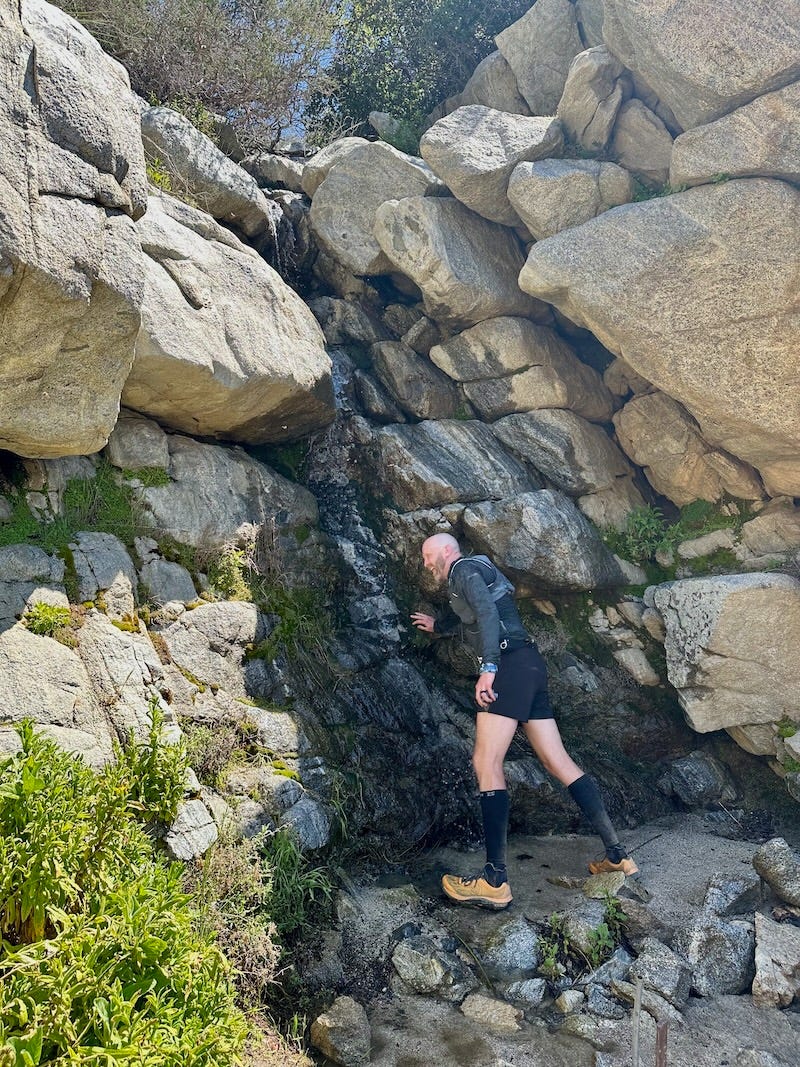
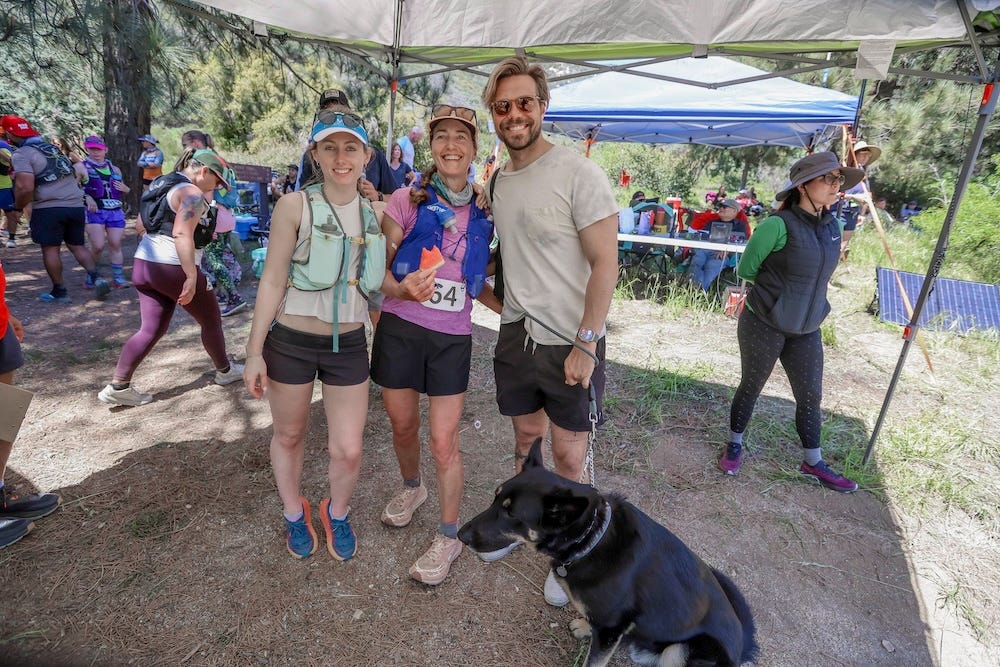
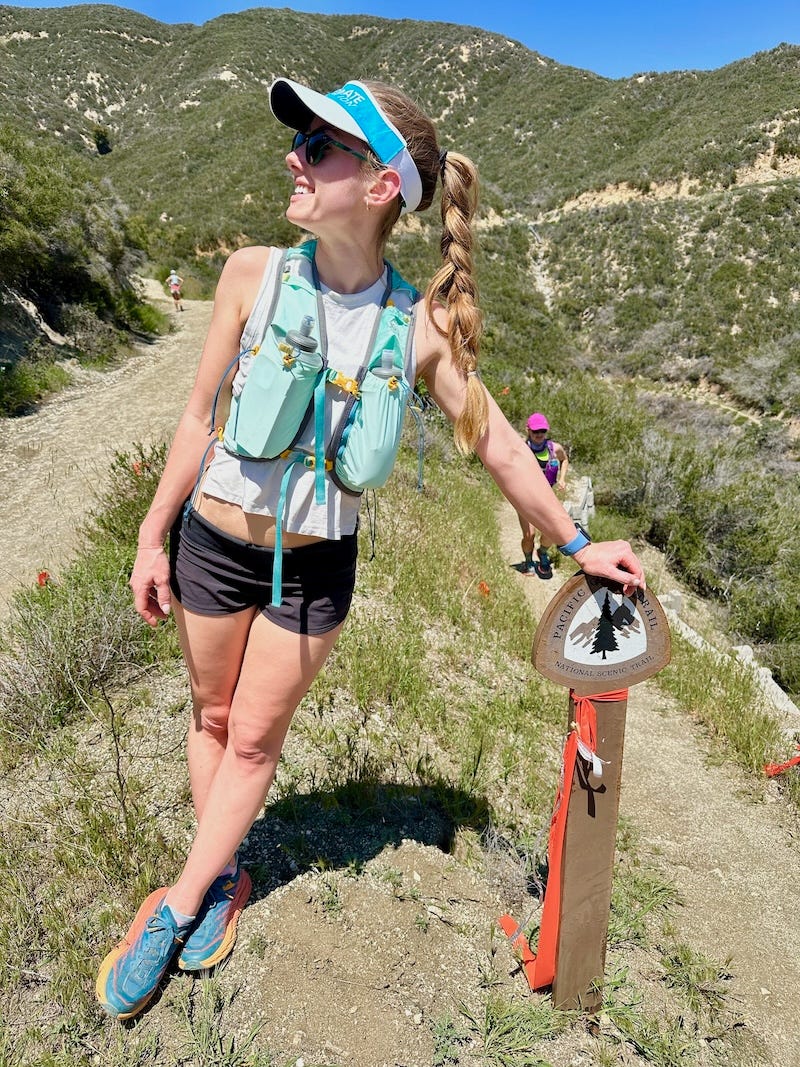
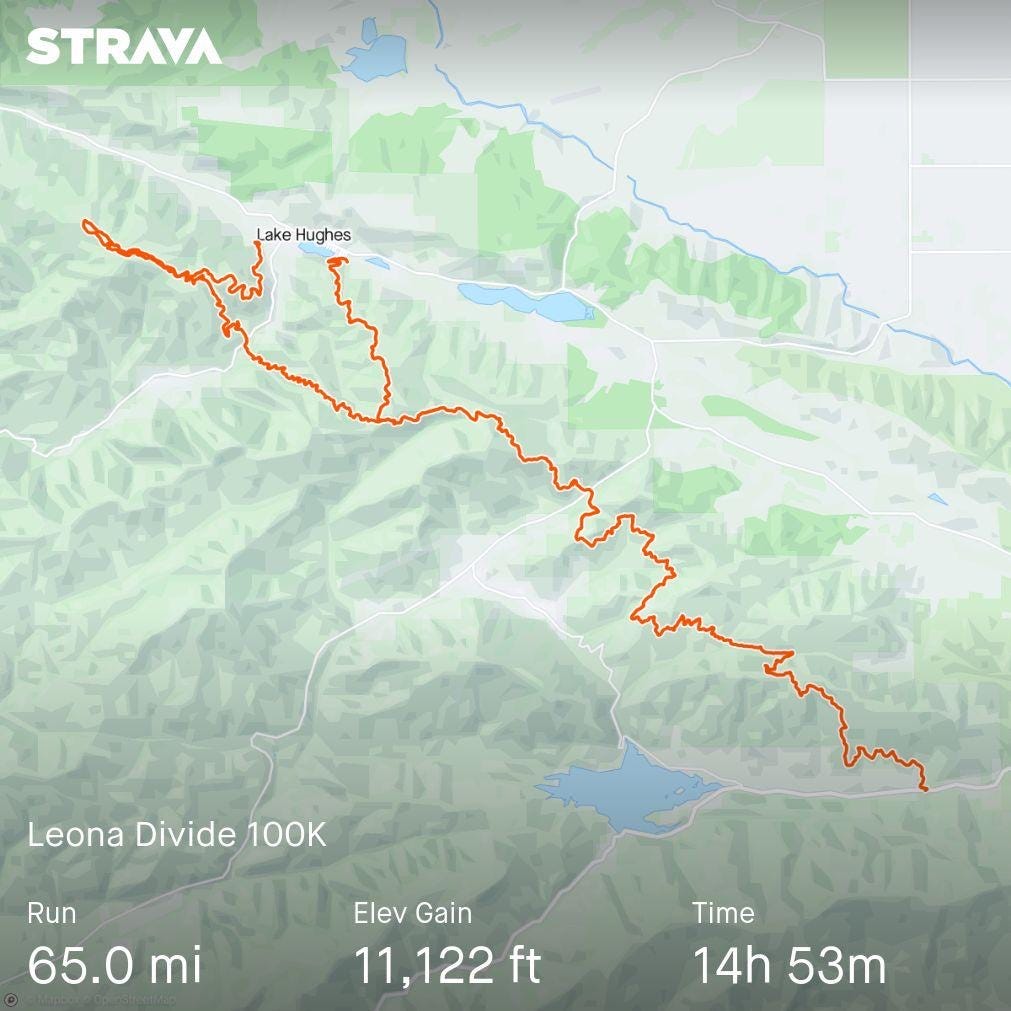
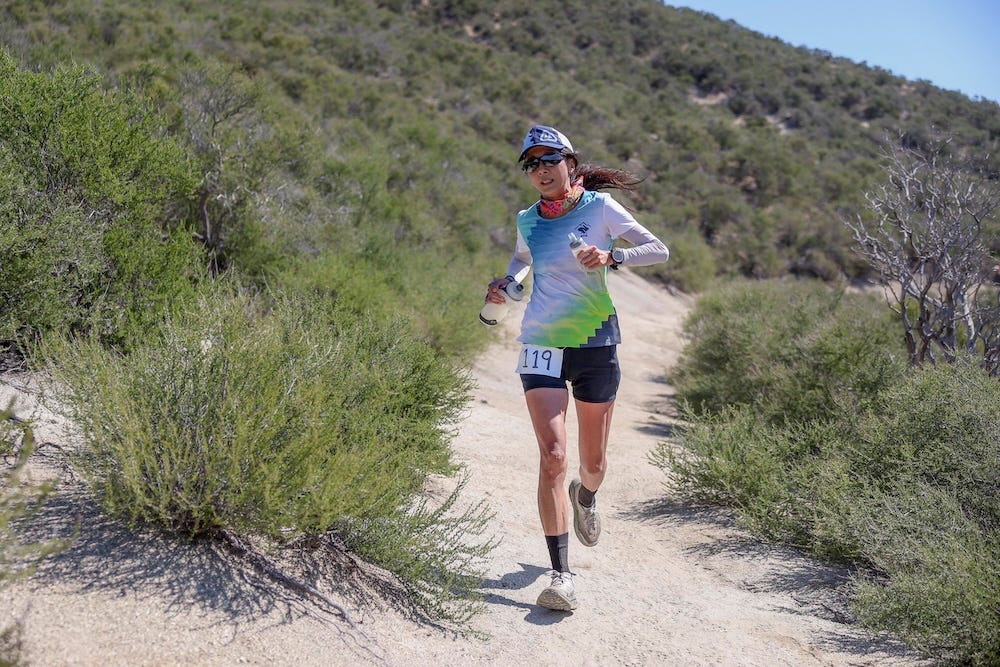
So freakin awesome!!!! Great recap. You are but an inspiration
I am so glad you featured Stella - I know her in person although I haven't talked to her since she got real fast. The thing she probably didn't mention is that apart from her out of this world physical abilities, she has a VERY strong mindset. She never gives up in the toughest condition. And she really wants it. I don't know what her "why" is.. but her mental strength is out of this world too.